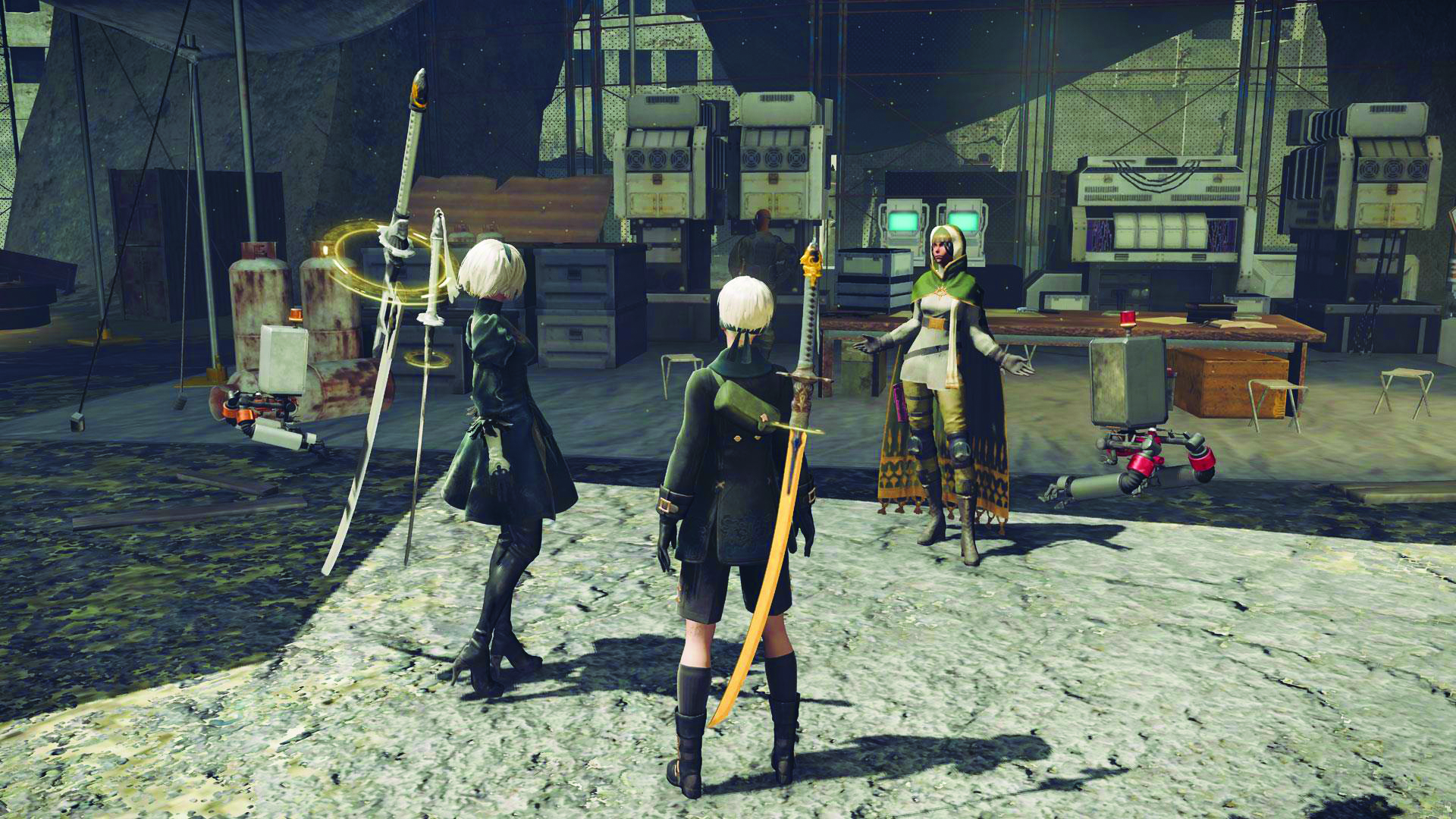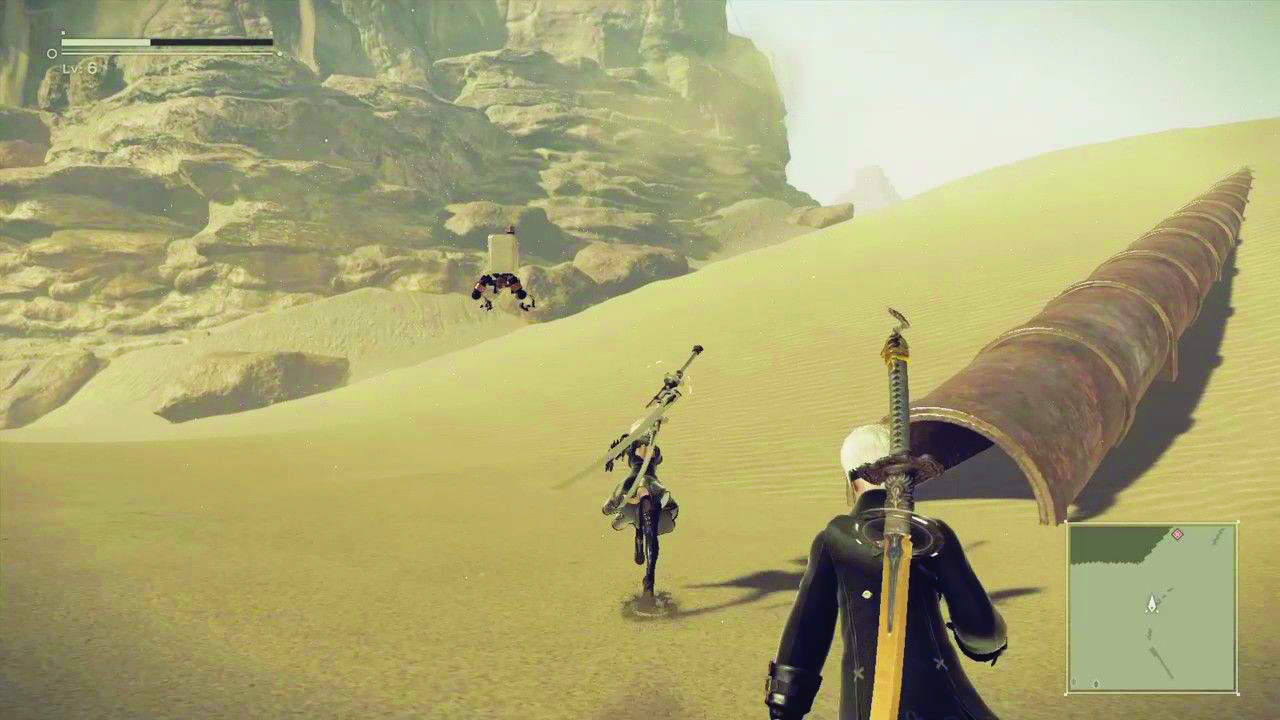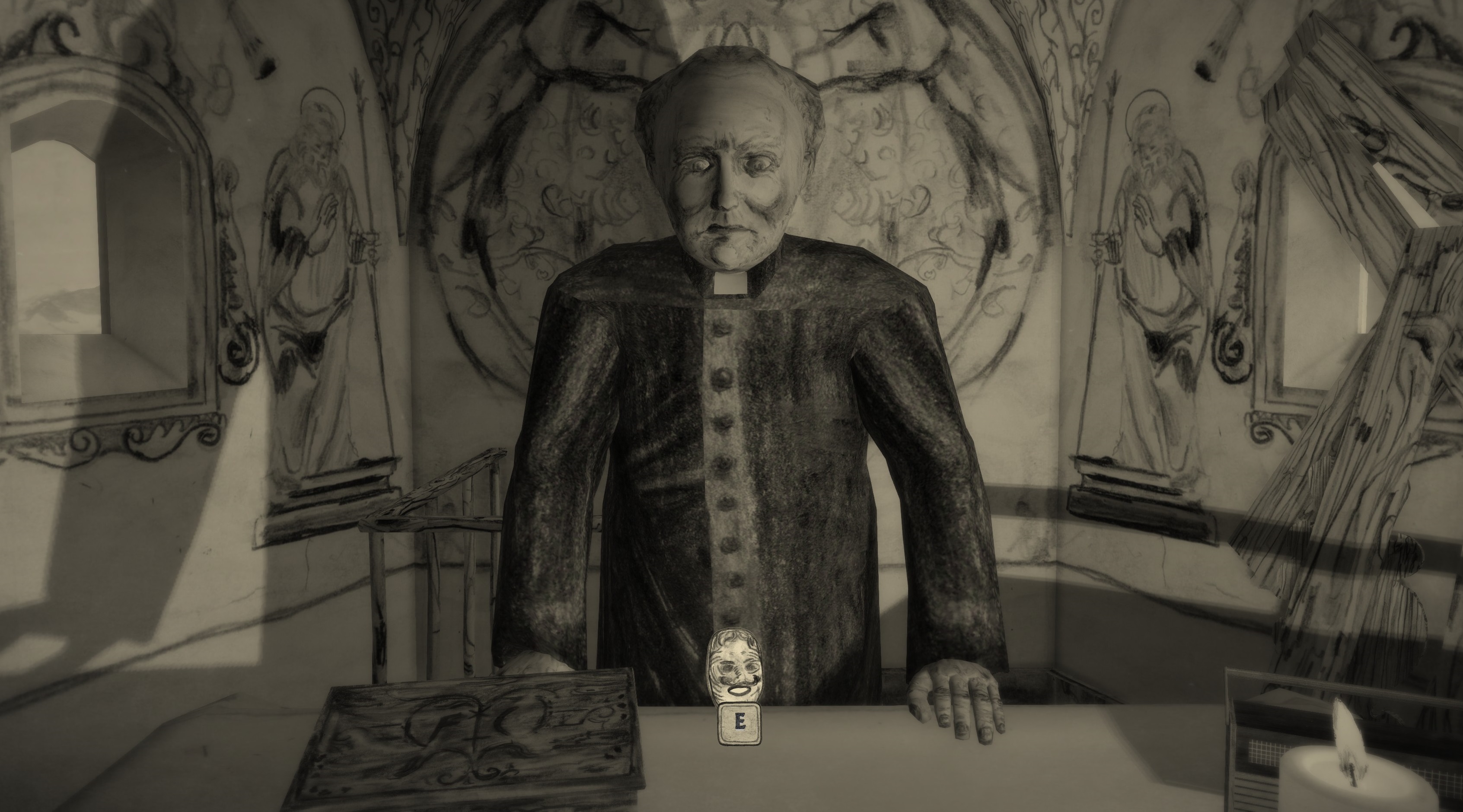PC Gamer plays: Nier Automata, Trials of Fire, Mundaun, and Elite Dangerous
The latest reports from virtual worlds by PCG's intrepid explorers.

Once more, the PC Gamer team returns from the far-flung frontiers of gaming to report on their adventures and discoveries. This month, Steven grapples with the idiosyncrasies of Nier: Automata, Robin explores the influence of tabletop gaming in Trials of Fire, Rachel goes horror hiking in the spooky Swiss Alps of Mundaun, and Matt attempts to play Elite Dangerous with a five year old.
Learning to love Nier: Automata's weirdness – Steven Messner
I am an idiot for not playing more of Nier: Automata when it first came out. Yoko Taro’s hybrid RPG-meets-brawler-meets-shoot-’em-up caught my interest the first time I played it back in 2017, but after getting to the end of the first of its many endings I just didn’t stick with it. Nier: Automata had me a little confused. I just didn’t get it at first. But I do now.
I’ve been replaying Nier: Automata in anticipation of Nier Replicant ver.1.22474487139... (yes, that’s it’s actual name), the remade prequel released this month. Also, it’s summer and there’s not a whole lot of new games to play. But I’m so glad I randomly decided to give Automata a second chance.
The way it blends genres is sublime, which is something I think I took for granted the first time I was playing it. It’s an RPG but with Platinum Games’ signature brawler combat, and occasionally it deviates into whole other genres like bullet-hell shooters. Mid-fight you’ll jump into a flight suit and suddenly be in an on-rails section, having to dodge projectiles littering the screen while shooting down enemy ships. It’s all extremely cool, and it makes Automata feel unpredictable in a way RPGs rarely do.
The combat is a lot of fun and I’ve begun to appreciate all the clever ways the RPG progression systems change and tweak it. Basic attacks and abilities can all be powered up by different chips, of which you can only equip a certain amount. But what’s brilliant is that these chips aren’t just for your combat abilities. The entire UI, like health bars and experience bars, are only displayed if you equip the proper chips. You can turn it all off if you want to squeeze out some extra attack damage, but then you’ll be flying blind. It’s brilliant.
Nier has tons of weird quirks like this. The first time I played it, I think I just found this all a little confusing and odd. But over the past few years I’ve really come to adore games that aren’t obsessed with being perfectly balanced and smoothed over. Friction is fun—especially when that friction forces you to engage with a game in unexpected ways.
The story is hitting a lot better for me too. One of Automata’s weaknesses is that it buries you under a mountain of sidequests which are mostly forgettable. I painstakingly completed as many of them as I could the first time around, I think that’s partly why I ultimately abandoned the game before properly finishing it. This time around, I’m skipping a good chunk of them and focusing on the story and it’s coming together in a much more engrossing way because I’m not taking hours-long detours between each twist.
Keep up to date with the most important stories and the best deals, as picked by the PC Gamer team.
I still haven’t quite beaten it yet, but Nier: Automata is quickly becoming one of my favourite games ever. It’s just so wholly unique—and that’s a hard thing to come by, especially in big-budget games that are typically made to appeal to as wide an audience as possible. Nier: Automata is a treasure.
Making a token effort in Trials of Fire – Robin Valentine
Since the very beginning of the hobby, videogames have been hugely influenced by tabletop games – but some certainly wear that influence a lot more on their sleeve than others. Trials of Fire is a roguelike that combines about as many mechanics inspired by tabletop games as you possibly could. Turn-based combat over a hex-grid, like a board game; character actions dictated by the drawing of cards from a deck, as in a CCG; levelling up, loot, and narrative events that trace their origins back to pen-and-paper role-playing.
Clever twists—like having to burn cards to gain the ‘willpower’ you need to fuel other cards, constantly forcing tough decisions—make all the difference. e
It all comes together wonderfully. Despite combining so many well-worn ideas (and having so much competition in the rapidly expanding roguelike word salad genre) its fights feel like a refreshingly different take on turn-based strategy. Clever twists—like having to burn cards to gain the ‘willpower’ you need to fuel other cards, constantly forcing tough decisions—make all the difference. It feels like a platter of established concepts given an exciting new flavour by some inventive seasonings.
But my favourite thing about Trials of Fire is that it’s not just inspired by its cardboard-and-paper predecessors in mechanics, but in its visuals too. As a modest budget game from a relatively small team, it was never going to be a graphical powerhouse. But where other teams might have gone for something like a retro pixel-art look or basic 3D models, Trials of Fire instead leans into its roots by representing all characters with counters.
These look like little plastic discs with some art of the hero or monster printed on top. As you move them around, they clack pleasantly onto the field. Sparking spell effects erupt incongruously out of them to blast towards enemies and slide them around the field. When hit by an attack, they jump and clatter about like someone’s got upset at board game night and slammed the table. In motion it’s a really striking and very endearing look, and one I would never have thought I’d find so impressive.
I’ve talked in previous issues about looking for a sense of physicality – there’s a satisfaction to picking up and placing a tangible object in a board game that videogames aren’t often interested in recreating. When a rare example can capture a little of that magic, I can’t help but be charmed.
Grappling with myths and monsters in hand-pencilled folk horror Mundaun – Rachel Watts
Switzerland’s rolling hills and snowy peaks seem like the ideal destination for a bit of peace and quiet. But in the horror game Mundaun, instead of being charmed by Swiss countryside, my first day in the snowy Alps ended with me scrambling around in the dark fending off monstrous wicker men with a broken pitchfork. My first day in town has been, in a word, surreal. The game’s heavy charcoal hand-drawn visuals really should have been my first clue that this was not going to be the getaway I had envisioned.
A little bit of context: you play as a young man named Curdin, who has returned to the secluded rural village of Mundaun after receiving a troubling letter. The local priest has written that Curdin’s grandfather has tragically died in a barn fire, but don’t worry—the funeral and burial have all been sorted, and there’s no reason why you should ever need to return to Mundaun, ever. So, of course, you go to investigate...
I search what is left of the barn, and my soul leaves my body as I come face-to-face with old grandpappy himself, the white of his open eyes standing out against the charred remains of the rest of his body.
After leaving the safety of the bus and a short hike later, I finally arrive at Mundaun and I’m immediately greeted by the burnt husk of my grandfather’s barn. I search what is left of the barn, and my soul leaves my body as I come face-to-face with old grandpappy himself, the white of his open eyes standing out against the charred remains of the rest of his body. That’s not all that lurks inside the barn, and within the ashy remains, something grabs my hand – a ghost, a phantom, or something else entirely. As they let go, I look down at my hand to see that it’s turned burnt and black like scorched tree bark.
But the troubles of my first day in Mundaun don’t end there. As I amble through the quaint meadows and peaks, I meet a stone-faced little girl who has only goats for friends and a hysterical priest who babbles on about demons, his church defiled with scrawlings of hellish retribution. They’re not much for company, and an uneasy feeling starts to sink in of just how alone and vulnerable I am.
Night begins to set in and as I head back to grandpa’s house I hear a hollow wailing. Peeking around a tree I see a group of ominous wicker men. They look like the monsters you’d see in bedtime stories meant to spook children, and would almost seem comical if it wasn’t for the incessant howling. As I try to defend myself with my broken pitchfork, I fumble for the box of matches in my bag, set these thankfully very flammable monsters ablaze, and run for the house, slamming the door behind me to block out their screams.
It’s only been one day in Mundaun but I already feel completely out of my depth. Delving into this village’s long-forgotten history feels like I’ve fallen head-first off the side of one of the mountains, hurtling down into the snowy depths. The Swiss Alps in Mundaun are certainly enchanting, but for all the wrong reasons.
Teaching a five-year-old to play Elite Dangerous – Matt Killeen
Playing Elite: Dangerous is like parenting—you are continually overestimating and underestimating the abilities of both your ship and child. You think your Vulture could just take on that wing of Deadly-ranked Eagles after an hour of swatting away sad little gangsters, then find yourself floating home. Similarly, my five-year-old son’s suggestion that he play that game where you “become like a police officer, but not, and shoot space pirates” should have given me pause.
However, after a lockdown grinding the Lego Star Wars games past the point where anything has maintained its lustre, I thought this was a good idea.
However, after a lockdown grinding the Lego Star Wars games past the point where anything has maintained its lustre, I thought this was a good idea. Elite has been woven into my being for 37 years. Could I hand down my love of the big black?
Besides, while bounty hunters are pretty much the bad guys in Star Wars, Elite: Dangerous promises a chance to be the police. At his age, conflict and goodies vs baddies are fundamental building blocks for child development. I wanted to encourage this tendency towards Lawful Good. His record as co-op gunner wasn’t good. He once shot a federal security Viper, whose friends turned my ship into a 40 million credit cloud of tinfoil. But we can’t play the simulations, as he wants it to be real. So, I bought him his own Sidewinder, and enough ARX to paint it, install the unnecessary fins and gills, and give his Holo-Me an unpleasant Action Man scar. Thus, the Small Attacker was born.
Of course, you can’t start out as a bounty hunter with just nominative determinism. He wanted an Anaconda, the apex predator of the Resource Extraction Site (Medium). But these monsters cost more credits than I have made in my 300+ hours. I was more worried about how he’d handle the difficult docking and launch process, but it turns out things have changed since my day. All ships start with a docking computer as standard. That precipitous learning curve is now a gentle slope, and to my immense pride, he breezed through the tutorial.
As soon he had his pilot’s licence, he suddenly wanted to be a miner. He found a High Tech system, purchased a mining laser, installed a refinery and headed for the nearest ringed planet. But when he got there, he just moved from asteroid to asteroid, carving gashes along their sides with his laser. Then I saw that he was actually writing his name.
There is an exquisite tension between what you want for your children, and what they are. Elite: Dangerous, like life, offers choice. You can be the scourge of the galaxy, go quietly about your business, or just muck about. It’s about doing your own thing, and he was. “Do my name next,” I told him.
Rachel had been bouncing around different gaming websites as a freelancer and staff writer for three years before settling at PC Gamer back in 2019. She mainly writes reviews, previews, and features, but on rare occasions will switch it up with news and guides. When she's not taking hundreds of screenshots of the latest indie darling, you can find her nurturing her parsnip empire in Stardew Valley and planning an axolotl uprising in Minecraft. She loves 'stop and smell the roses' games—her proudest gaming moment being the one time she kept her virtual potted plants alive for over a year.









